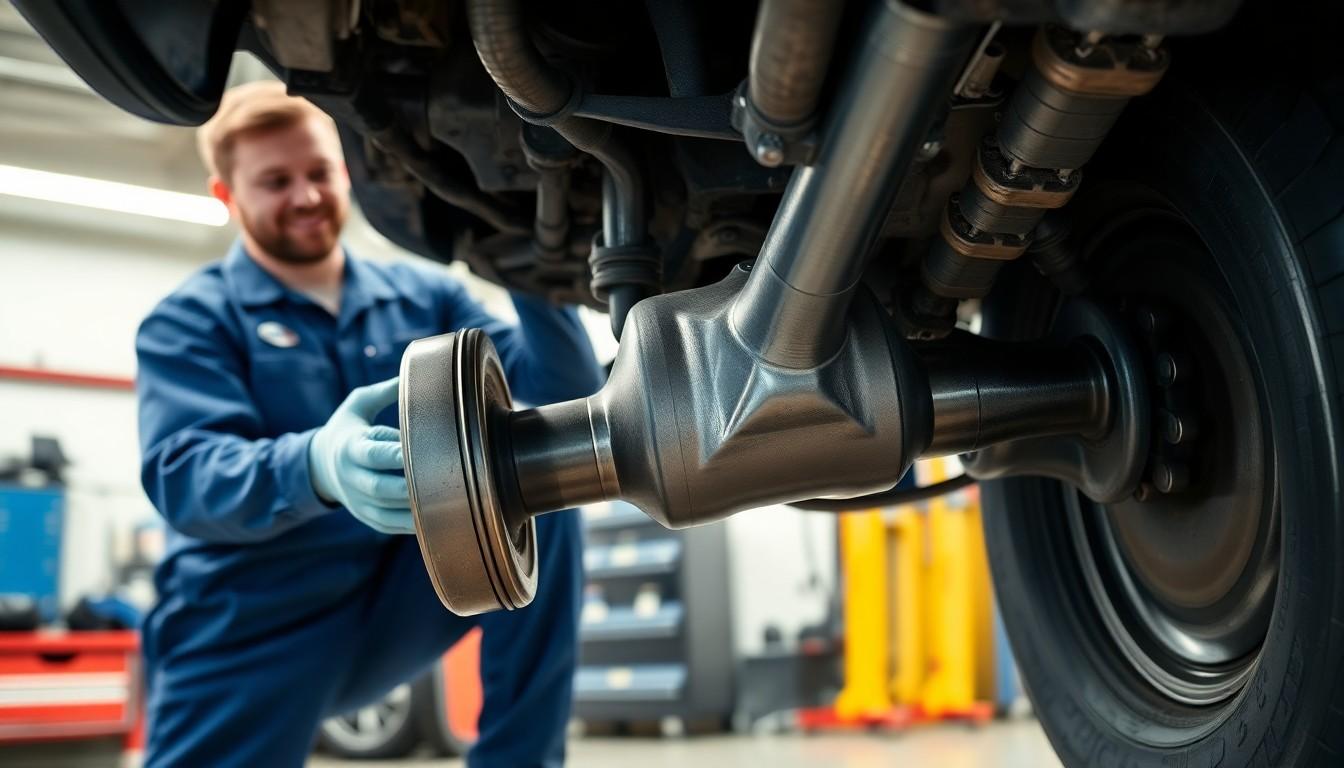When we think about how our cars actually move, we often overlook one of the most crucial components: the axle. This unsung hero transfers power from your engine to your wheels, literally keeping you rolling down the road. Without properly functioning axles, your car would be nothing more than an expensive piece of stationary metal.
We’ve noticed many drivers don’t fully understand what axles do or why they’re so important until something goes wrong. Whether you’re hearing strange clicking noises when turning or experiencing vibrations at certain speeds, axle issues can significantly impact your driving experience and safety. In this comprehensive guide, we’ll break down everything you need to know about car axles—from their basic function to warning signs that might indicate it’s time for a replacement.
What Is an Axle in a Car: Essential Component Explained
An axle is a central shaft that connects a vehicle’s wheels and supports the weight of the car while allowing the wheels to rotate. Car axles transmit power from the transmission to the wheels, enabling the vehicle to move forward or backward. These sturdy metal rods are designed to withstand important stress, including the vehicle’s weight and torque generated during acceleration.
Modern vehicles typically have two main axles: the front axle and the rear axle. Front axles help steering and absorb shocks from uneven road surfaces, while rear axles primarily deliver power to the wheels in rear-wheel-drive vehicles. In four-wheel-drive or all-wheel-drive configurations, both axles actively transfer power to all wheels.
Car axles come in several types based on their design and functionality:
- Drive axles: Connect directly to the driveshaft and transfer power from the engine to the wheels
- Dead axles: Support weight but don’t transmit power, commonly found in trailers
- Floating axles: Bear only rotational force while the vehicle’s weight rests on the axle housing
- Semi-floating axles: Support both the vehicle’s weight and rotational forces
The design of axles has evolved significantly over automotive history. Early vehicles featured solid axles that connected both wheels on the same axis, while many modern cars use independent suspension systems with split axles that allow each wheel to move separately. This evolution has improved handling, ride comfort, and overall vehicle performance by allowing wheels to respond independently to road conditions.
Types of Car Axles and Their Functions
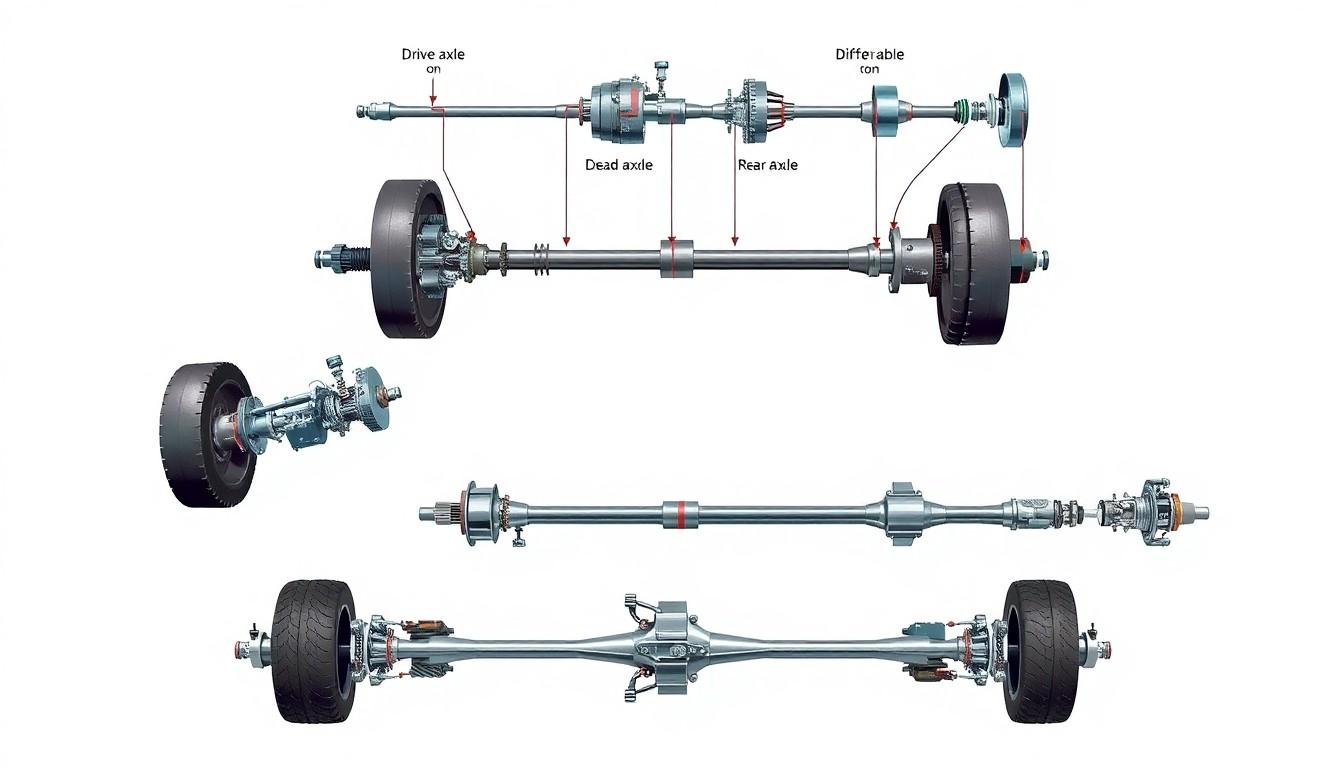
Car axles come in several types, each serving exact functions in a vehicle’s operation. Understanding these different axle types helps diagnose potential issues and appreciate how your car transfers power and maintains stability.
Drive Axles vs. Dead Axles
Drive axles actively transfer power from the engine to the wheels, enabling vehicle movement. These “live” axles consist of two half shafts connected by the differential, working together to convert the engine’s rotary power into wheel motion. Their primary purpose involves transmitting torque from the transmission to the wheels, making them essential for vehicle propulsion.
Dead axles, in contrast, don’t transmit any power to the wheels. These axles simply support the vehicle’s weight and maintain wheel positioning. Found in non-driven wheels, dead axles focus entirely on structural support rather than power delivery. Many trailers and some non-driving wheels on larger vehicles use dead axles because they don’t require power transmission capabilities.
Front vs. Rear Axles
Front axles serve dual purposes in most vehicles – steering assistance and shock absorption from uneven roads. Located at the vehicle’s front end, these axles feature several key components: the beam, swivel pin, track rod, and stub axle. Manufacturers typically construct front axles using durable materials like carbon steel or nickel steel to ensure they withstand important stress. The stub axle attaches to the front wheels, with kingpins connecting these components to the main front axle.
Rear axles focus primarily on delivering power to the driving wheels in rear-wheel and all-wheel drive vehicles. These axles typically split into two half shafts joined by the differential, allowing the wheels to rotate at different speeds during turns. Most rear axles fall into the “live” category, meaning they rotate with the vehicle’s wheels. Unlike front axles, rear axles prioritize power transmission over steering functions, though they still provide crucial weight support for the vehicle’s rear.
Different vehicle designs incorporate various axle configurations depending on their intended use, driving characteristics, and manufacturing considerations. Front-wheel drive vehicles often use a transaxle system that combines transmission and axle functions into a single unit, while performance vehicles might feature specialized axle designs to enhance handling and power delivery.
How Car Axles Work: The Mechanics Behind Vehicle Movement
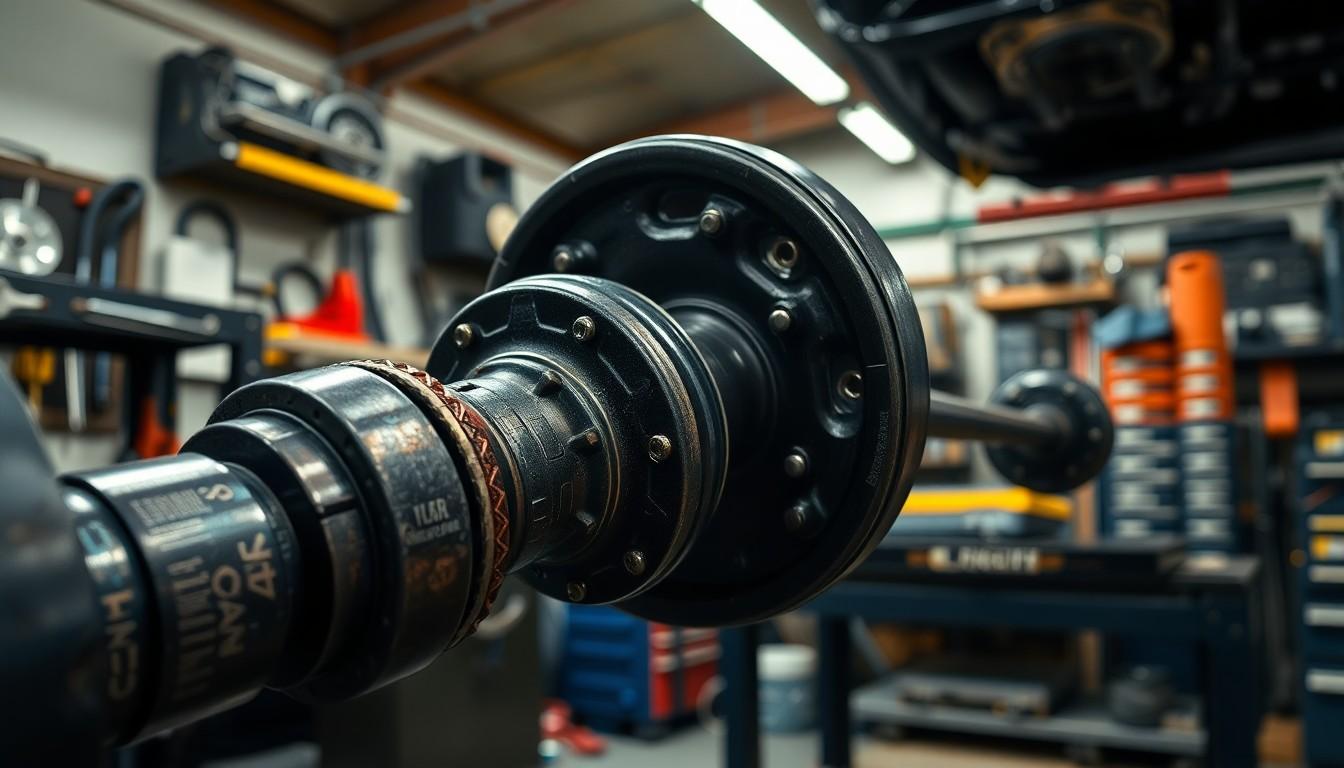
Car axles function as crucial mechanical components that enable vehicle movement through power transmission and structural support. These essential parts connect the wheels while transferring the rotational force needed for driving.
Power Transmission From Engine to Wheels
Axles serve as the vital link in transferring power from the engine to the wheels. This transmission process begins when the engine generates rotational energy that travels through the transmission and differential before reaching the axles. The differential plays a particularly important role by allowing wheels on the same axle to rotate at different speeds during turns – an absolute necessity for smooth cornering. In front-wheel drive vehicles, the front axles handle power delivery, while rear-wheel drive cars rely on rear axles for propulsion. All-wheel drive vehicles use both front and rear axles to distribute power across all wheels, providing enhanced traction in various driving conditions.
Load-Bearing Capabilities
Axles support the entire weight of the vehicle plus any additional cargo and passengers. These components must withstand tremendous vertical loads while simultaneously managing the torque forces during acceleration and the resistive forces during braking. Modern axles are engineered from high-strength materials such as forged steel or carbon fiber composites to handle these complex stress patterns. The load distribution varies between front and rear axles depending on the vehicle’s design, with most passenger cars carrying 60% of weight on the front axle. Heavy-duty vehicles often feature reinforced axles with larger diameters and specialized alloys to accommodate increased load requirements. This dual functionality of power transmission and weight support makes axles fundamental to both the mobility and structural integrity of any vehicle.
Signs of a Damaged or Failing Axle
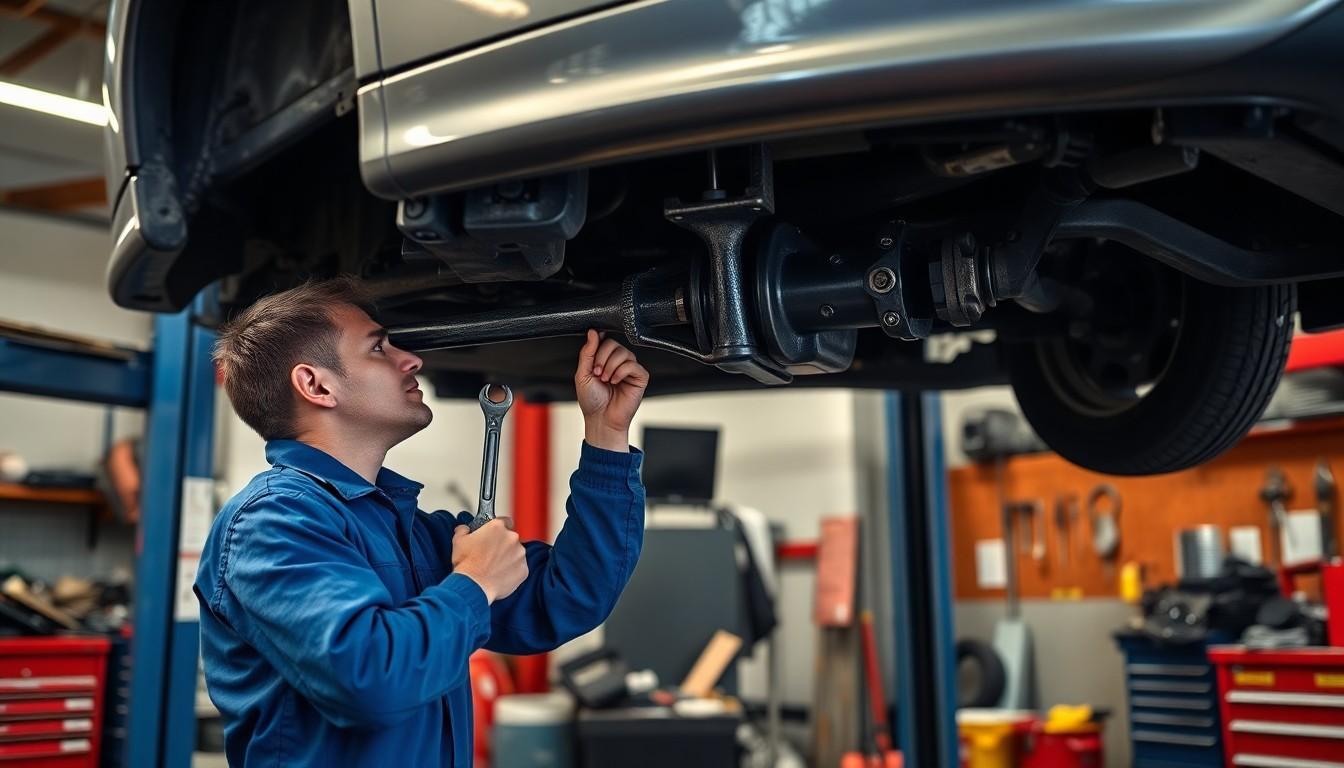
Recognizing the warning signs of axle problems can save you from costly repairs and dangerous driving conditions. Damaged axles compromise your vehicle’s performance, safety, and handling in several noticeable ways.
Unusual Vibrations and Noises
Vibrations throughout your vehicle often indicate axle damage, particularly when accelerating or decelerating. These vibrations typically travel through the steering wheel, seat, or floor, creating an uncomfortable driving experience. Distinctive sounds like clunking, clicking, or grinding noises coming from the wheel area suggest potential axle issues that require immediate attention. These audible warnings become more pronounced during turns or gear changes, serving as clear indicators that your axle may be failing. Regular inspection helps identify these symptoms early before they develop into more severe problems.
Impact on Vehicle Performance
A failing axle significantly reduces your vehicle’s stability and handling, making steering more difficult and compromising your ability to maintain a straight driving path. Power transmission efficiency decreases with axle damage, resulting in reduced performance where your car may struggle to move or even stall unexpectedly. Braking effectiveness can also become compromised since axles play an important role in the braking system, potentially causing uneven braking or diminished stopping power—a serious safety hazard during emergency situations. Vehicles with damaged axles often exhibit unpredictable behavior, including pulling to one side or shuddering during acceleration, making regular maintenance critical for both performance and safety.
Axle Maintenance and Replacement

Car axles require regular maintenance and occasional replacement to ensure vehicle safety and performance. Proper care extends axle lifespan and prevents unexpected breakdowns on the road.
When to Replace Your Car’s Axle
Regular visual inspections reveal early signs of axle problems before they become serious issues. During routine maintenance appointments, mechanics typically examine axles for cracks, rust, or structural damage that might compromise their integrity. Common warning signs indicating axle replacement include unusual noises (particularly clunking or clicking sounds), persistent vibrations felt through the steering wheel or floorboard, and difficulty steering. Damaged axles often lead to uneven tire wear patterns, reduced vehicle stability, and potentially dangerous driving conditions. Addressing these symptoms promptly prevents more extensive damage to your vehicle’s drivetrain components and ensures continued safe operation.
Maintenance Costs and Considerations
Axle maintenance costs vary significantly based on vehicle type, damage extent, and whether it’s a front or rear axle requiring attention. Replacement expenses typically range from several hundred to thousands of dollars, including both parts and labor costs. Front axle repairs generally cost more than rear axle work due to their complexity, especially in front-wheel drive vehicles. Regular maintenance practices like proper wheel alignment, scheduled tire rotations, and avoiding extreme driving conditions substantially extend axle lifespan. Driving cautiously over speed bumps, potholes, and rough terrain reduces impact stress on axle components. Many vehicle manufacturers recommend inspecting axle boots and CV joints during oil changes to catch small issues before they escalate into major repairs. Preventative maintenance proves far more economical than emergency axle replacement resulting from complete failure.
How Axles Differ Across Vehicle Types
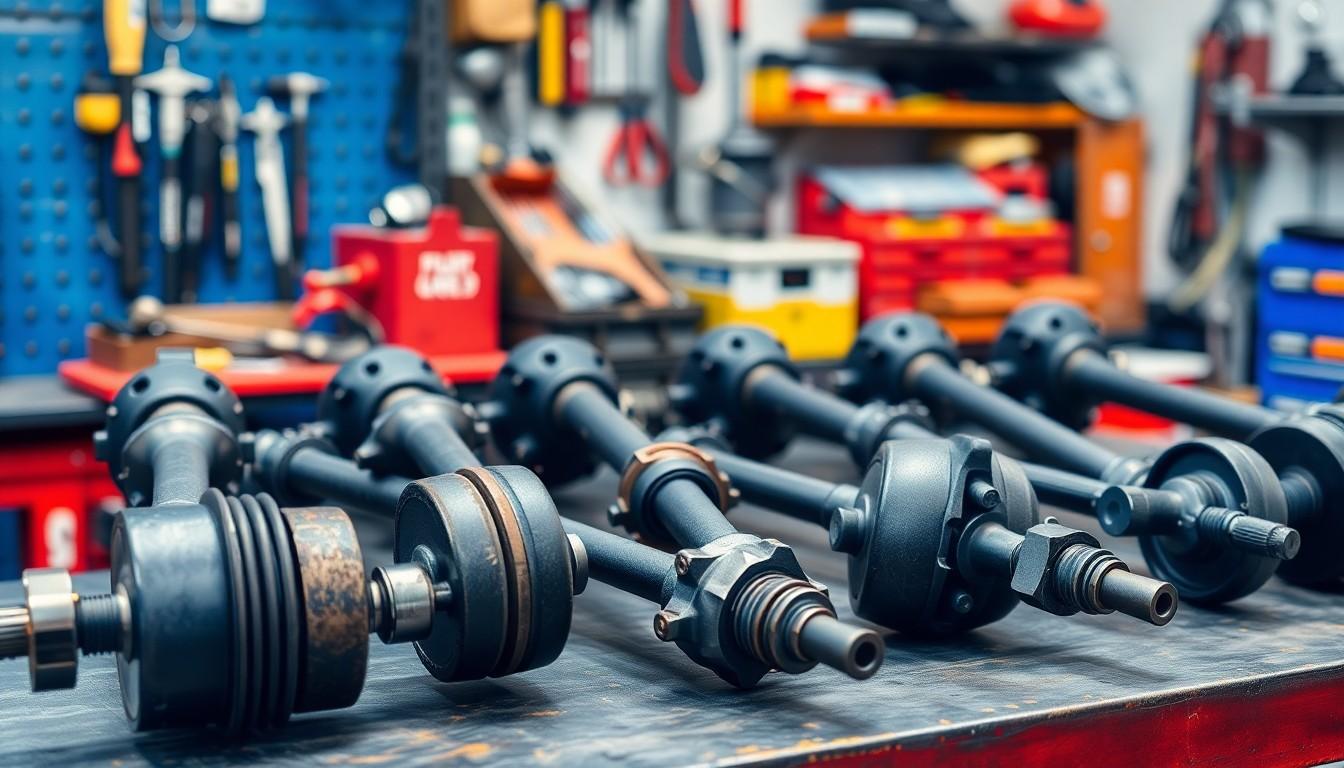
Axle configurations vary significantly across different vehicle types, each designed to meet exact performance needs and driving conditions. These variations impact everything from load capacity to handling characteristics.
Passenger Cars vs. Trucks and SUVs
Trucks and SUVs feature axles with substantially higher load capacities than those found in passenger cars. Their robust construction allows them to handle greater stress from increased vehicle weight and cargo loads. Axles in larger vehicles are typically built with thicker, more durable materials to withstand the demanding conditions these vehicles often face. Passenger cars, by contrast, use lighter axle designs optimized for efficiency and smoother ride quality rather than maximum load bearing capability. The durability factor becomes especially important for trucks and SUVs that frequently traverse rough terrain or carry heavy payloads, requiring axles that can endure consistent strain without failing.
Front-Wheel Drive vs. Rear-Wheel Drive Axle Systems
Front-wheel drive (FWD) vehicles employ a unique axle configuration where the front wheels receive power through constant velocity (CV) axles or half shafts. Each front wheel connects to its own dedicated axle shaft, while the rear wheels use “dead axles” that allow rotation without delivering power. The entire drivetrain packaging differs significantly from other configurations, with the engine, transmission, and differential often combined into a single transaxle unit.
Rear-wheel drive (RWD) systems reverse this arrangement, delivering power to the rear wheels through a drive axle while the front wheels connect to a non-powered axle. RWD vehicles typically carry out either solid axles or independent suspension systems with half shafts connecting to the rear wheels. This configuration creates different driving dynamics, with improved weight distribution and potentially better handling characteristics in certain driving conditions.
All-wheel drive (AWD) vehicles incorporate a more complex system where both front and rear axles function as drive axles. Multiple differentials and transfer cases distribute power between the axles, allowing for adjustable power delivery based on traction needs. This sophisticated setup enables AWD vehicles to adapt to varying road conditions by transferring power to the wheels with the most grip. The complexity of AWD axle systems makes them more expensive to manufacture and maintain, but their versatility offers important advantages in challenging driving environments.
Conclusion
Car axles are the unsung heroes of our vehicles serving as critical components that enable movement while supporting weight. They’re engineering marvels that transfer power from the engine to the wheels through complex mechanical systems.
Understanding your car’s axle system helps you identify potential issues before they become dangerous or expensive problems. By recognizing warning signs like unusual vibrations unusual noises or handling difficulties you’ll be better equipped to maintain your vehicle properly.
Whether you drive a lightweight sedan or a heavy-duty truck proper axle maintenance ensures optimal performance safety and longevity. Remember that different vehicle types use exact axle configurations designed for their unique purposes making these components truly fundamental to your driving experience.
Frequently Asked Questions
What is a car axle and why is it important?
A car axle is a central shaft that connects the wheels, supporting the vehicle’s weight while enabling wheel rotation. It’s critically important because it transfers power from the engine to the wheels, allowing the vehicle to move. Without properly functioning axles, your car couldn’t transfer power to the wheels or maintain structural integrity during driving.
What are the main types of car axles?
The main types include drive axles (transfer power to wheels), dead axles (provide support only), floating axles (bear no weight), and semi-floating axles (bear partial weight). Most modern vehicles have two main axles: front axles for steering and shock absorption, and rear axles for power delivery in rear-wheel-drive vehicles. Each type serves specific functions based on the vehicle’s design and intended use.
What are signs of a damaged axle?
Key warning signs include unusual vibrations felt through the steering wheel, seat, or floor; strange noises like clunking or grinding, especially during acceleration or turns; reduced vehicle stability and handling; difficulty steering; and compromised braking performance. These symptoms indicate potential axle damage that requires immediate attention to prevent more serious safety hazards.
How often should car axles be replaced?
Car axles don’t have a standard replacement schedule as they’re designed to last the vehicle’s lifetime under normal conditions. However, factors like rough driving, accidents, and exposure to harsh elements can cause premature wear. Regular inspections during routine maintenance can help identify potential issues before they become serious problems requiring complete replacement.
How much does axle replacement cost?
Axle replacement costs vary significantly depending on vehicle make, model, and whether it’s front or rear axle work. Generally, prices range from $500 to $1,000+ per axle including parts and labor. Front axle repairs typically cost more due to their complexity. Luxury or specialty vehicles often incur higher expenses. Preventative maintenance can help avoid unexpected emergency repairs.
How do axles differ between car types?
Trucks and SUVs have robust axles designed for higher load capacities and durability, while passenger cars have lighter axles optimized for efficiency. Front-wheel drive vehicles use constant velocity axles for front wheels, rear-wheel drive cars employ drive axles for rear wheels, and all-wheel drive vehicles feature complex systems allowing adjustable power delivery based on traction needs. These configurations impact handling characteristics and performance.
Can I drive with a damaged axle?
Driving with a damaged axle is extremely dangerous and not recommended. A compromised axle can fail completely while driving, potentially causing loss of vehicle control, wheel detachment, or serious accidents. If you notice symptoms of axle damage like unusual vibrations, noises, or handling issues, have your vehicle towed to a repair shop immediately rather than risking further driving.
How can I extend the life of my car’s axles?
To maximize axle lifespan, maintain proper wheel alignment and tire balance, drive cautiously over speed bumps and rough terrain, avoid overloading your vehicle beyond its capacity, ensure regular lubrication of CV joints and boots, promptly address any unusual noises or vibrations, and follow your vehicle’s maintenance schedule. These preventative measures can significantly extend axle service life.

